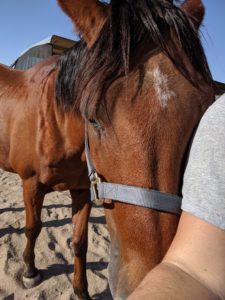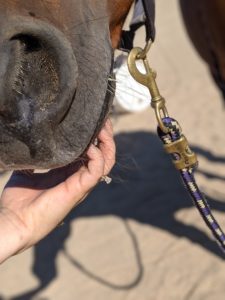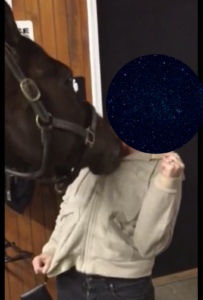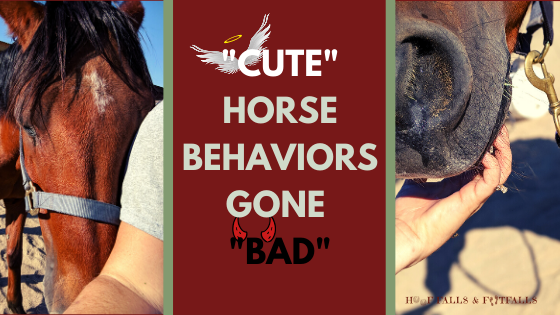Do any of these scenarios sound familiar:
Scenario #1
You are walking out of the arena and heading over to check the equipment on the horses working in your next lesson.
You see a horse rubbing his head on the shoulder of a sidewalker who is standing close to him. The sidewalker stands there and the team starts to laugh saying how funny it is and joking how great of a scratching post they make.
You think to yourself “I should really go talk to them”…but then you feel bad because they are laughing and think it’s cute and you really don’t want to have someone get their feelings hurt….and it’s probably only a one time thing….
Scenario #2
You are walking down the barn aisle and see one of the awesome volunteers cleaning stalls when a horse approaches her. She stops cleaning, gives him a few scratches on his neck, then starts giggling when the horse first nuzzles around her pockets and then grabs her jacket zipper with their lips and starts zipping it up and down.
Again….you think to yourself “I should really go talk to her”…but then you feel bad because she is laughing and thinks it’s cute and you really don’t want to have someone get their feelings hurt and burst their bubble….and it’s probably only a one time thing….
Scenario #3
You are in the middle of class and call all the students over to explain the next activity. While you are explaining things, you notice two of the four volunteers standing next to the horses and nonchalantly playing with the horses lips while they wait for you to send everyone back out to practice the pattern.
Again….you think to yourself “I should really talk to them”…but then you feel bad because they are in class, the humans are relaxed, and you really don’t want to have someone get their feelings hurt (You can’t loose a horse leader!!!)….and it’s probably only a one time thing….
So what do all these situations have in common?
Each situation describes an equine being allowed, or encouraged, to do what is seen as “cute” or “funny” in the moment. But each behavior can have a domino effect that could turn into what is seen as a “bad” or dangerous behavior.
Every thing that we do with our horses can either reinforce good behavior or bad behavior.
Even unintentional actions can reinforce behaviors that can either benefit or harm our horses in the long run.
Every single action we take with the horse must eventually come from intentional thought…from how we greet them to how we allow them to stand next to us while waiting for a student to mount.
Every single behavior we allow and every action we take should be thoroughly thought through so we can understand how it may impact our horse long term….for the good or for the bad.
When a horse is a one person horse, or maybe even a family horse, there are few factors that play into reinforcing these good or bad behaviors: the owner, the person who feeds and cleans (if you happen to board somewhere), and maybe a few occasional family members or friends that come see your horse.
Horses that are in an Equine Assisted Activities or Therapies (EAAT) have many more factors: instructors, students, volunteers, other staff, visitors, etc. Despite all these factors we must do our best to set our horses up for success and be on the lookout for “cute” behaviors that can turn “bad” and possibly harm their longevity in a program.
But how do we do that? Through consistency and being aware of what “cute” behaviors can turn “bad”
Maintaining Consistency With our Horses is HARD…
Maintaining consistency is hard is due to the fact that an EAAT (Equine Assisted Activities and Therapies) center has more factors that impact uniformity than a typical barn.
It is imperative that consistency is maintained because when we allow a horse in an adaptive riding program** to do something we are not just allowing that horse to be “good” or “bad” for us but we are also also shaping how they will be seen and interact with students, volunteers, donors, etc.
Without a doubt, my time spent as Equine Director at a large adaptive riding program was some of the most stressful time in my ten year career at a Premier Accredited Center. There were so many factors to manage…..it was like herding cats and ducks all at the same time and trying to get everything in a row without someone getting eaten, flying away, or leaving the group. I would take the stress of Program Director over that of Equine Director any day!
During that time I did learn the important lesson of realizing that a big piece of setting our equines up for success, happiness, and longevity in any size program is maintaining clear, consistent boundaries when it comes to how not only the horses should behave but also the humans. This is a very hard and never ending task…but we owe it to our equine coworkers to do the best we can while managing them.
Did you know that most horses in an Equine Assisted Activities or Therapies program “burn out” and display “bad” behaviors soon after starting in a program and are “retired” from that program in 6-18 months? Yes…there are horses that work longer…but those equines are often the ones in programs or barns that maintain a very high level of consistency across the board (handling, behavior expectations, husbandry, etc)
Maintaining consistency when you teach Adaptive Equine Activities can get tricky when you have multiple people handling the horse because EVERY SINGLE PERSON either reinforces “good” behavior or “bad” behavior when they are interacting with a horse.
Notice I said “interacting” and not “handling” or “leading”. Even those people who are in the proximity of the horse can reinforce behaviors…..it’s not just the immediate handlers.
If EVERY SINGLE PERSON is not on board with consistency and reinforcing the same things then we are setting up our horses for failure and confusion.
Letting things slip….
Often “bad” behavior is unknowingly reinforced by big hearted people who are uneducated in equine communication and/or the long-term impact of letting a horse do something that appears “cute” or funny in that moment but snowballs into a bigger, “bad” behavior down the road.
Sometimes we, as instructors, reinforce “bad” behavior by letting things slip and not address them because we 1) don’t want to deal with it right then or 2) have not thought of/are unaware of the possible long-term impacts it might have on the horse not only that day but years down the road.
- Do you sometimes let things slip because its ‘just’ a volunteer or ‘just’ a student that is letting the behavior happen?
- Do you let something that can spiral into a bad behavior happen because you don’t want to hurt that person’s feelings by kindly explaining what is happening and why it is not ok? (after all it’s just soooo ‘cute’ to them it can’t be bad!)
- Do you not address something because you feel like a broken record and might go crazy if you have to explain the same thing for the ten thousandth time? Ok…maybe only in hundreds but it sure does feel like quadruple digits of ‘reminders’.
When we let things slip we can be missing an opportunity to not only educate those interacting with the horses but also set our horses up for potential behaviors that could turn bad down the road which could jeopardize their longevity in a program or even their chance to find a good retirement home.
Let’s take a look at some things that we often let slip either by choice or not knowing the long-term negative effects it may have on our equines.
So what “cute” behaviors can turn “bad” long term…or even immediately?
Here are the top 4 “cute” behaviors I see go “bad”:
-
 Head rubbing on people– “But he’s just so itchy” “It’s ok, I really don’t mind being a scratching post”
Head rubbing on people– “But he’s just so itchy” “It’s ok, I really don’t mind being a scratching post”-
The horse is not respecting the person’s space (their head is literally all over the person’s body).
-
If a horse is allowed to do this on adult sized leaders or volunteers they will most likely try this on one of our students. If you teach Adaptive (therapeutic) Riding or Horsemanship then you most likely have students that have balance and coordination difficulties on their own without a thousand pound animal rubbing their head on them.
-
The halter and/or bridles on a horse can hurt the human scratching post (I don’t know about you but I like to avoid writing up incident reports!)
-
An instructor or volunteer allowing a hose to do this sets a bad example of ‘maintaining’ boundaries to the students who may be watching
-
- Nuzzling, nosiness, grabbing clothing, etc– “It’s ok, I think its cute when he grabs my sleeve” “I think it’s cute when he tries to find treats”
- The horse is not respecting the person’s space. Their nose is all over the person’s body and clothing.
- Nuzzling and nosiness can easily turn into nipping and biting. That is not a fun behavior to reverse. This can lead to more pushy behavior if the horse does not get the reaction from the human they were wanting.
- When the horse nuzzles the human face or neck area it personally makes me cringe. Horse teeth > human face/neck.
 Playing with horse’s mouth– “It’s so soft” “It’s so silly when he wiggles his lips”
Playing with horse’s mouth– “It’s so soft” “It’s so silly when he wiggles his lips”
- Often times the human initiates this and is then not respecting the horse’s space and is allowing the horse to not respect theirs.
Playing with the mouth encourages mouthiness and biting. You are basically asking the horse to start along the path that leads to the “bad” behavior of biting. - The horse often “tells” the human through nonverbal communication that they are not ok with their mouth being played with but that communication often goes ignored. Ignoring the “whispers” from our horses leads into louder communication which can be seen as “bad” or dangerous behavior.
- Often times the human initiates this and is then not respecting the horse’s space and is allowing the horse to not respect theirs.
-
 Mouth grabbing the lead rope or reins– “Ha ha, look! She’s holding the lead” “It’s like playing tug of war with my dog!”
Mouth grabbing the lead rope or reins– “Ha ha, look! She’s holding the lead” “It’s like playing tug of war with my dog!”-
The horse is not respecting the human’s space or equipment that is in their space.
-
This can lead to safety issues because the horse may grab a finger instead of the lead rope.
-
A horse grabbing a lead rope or rein in their mouth can also interfere with the ability of the horse leader and/or rider to be able to direct the horse (since the equipment is in the horse’s mouth!)
-
This is a quick way to damage equipment that you will have to replace which means money out of your pocket or the program’s budget.
-
Are there any other ‘cute’ behaviors you see happening with horses that can cause safety issues and/or set them on the path to a more long term, bigger “naughty” behavior?
This article has some great points about the importance of reinforcing good manners on the ground and in the saddle.
Final Tips
- Remember to think about the long term results– if a horse is allowed or encouraged to do “X”, what will that look like down the road. Does “X” lead into other behaviors (good or bad).
- Advocating for your horse does not have to come at the price of hurting feelings– When you have to approach another person about allowing the horse to behave inappropriately, explain “why” you are asking the horse to not be allowed to do something. Use it as a teachable moment. But, if feelings do get hurt remember that you are in control of your feelings, not others, and ultimately it is likely part of your job to advocate for your equine co-worker. I highly recommend this book Crucial Conversations which gives some helpful tools for when we have to have these more difficult conversations.
- Realize that an adaptive riding ‘program’ or ‘barn’ that has multiple people handling horses has a different set of challenges than if it were just you and the horse…or even you, a horse, and one student– Identify these challenges and factors, accept the challenge, and figure out how to overcome them. When there are many hands on the horses and often hands of different skill levels who may or may not how to read horses, understand equine behavior, etc. then sometimes black and white rules and policies work a little better. Grey area polices, or polices that leave room for interpretation or exceptions to the rules, often do not work well when you have multiple people involved.

** I personally chose to use the term Adaptive Riding vs. Therapeutic Riding and avoid ‘horse therapy’ at all costs. Why? CLICK HERE. The thoughts shared in the post above apply to not only Adaptive riding but also to other mounted equine activities and therapies offered at an EAAT (Equine Assisted Activity and Therapy) Program/Center/Barn.


I totally agree with the difficulty involved in talking with friends and family who just love to hand feed my horses carrots or other treats. It is fun to watch them enjoy the interaction but I have learned to set limits. Horses in a therapeutic riding center are in a different environment. They have to have a different set of rules. I agree with your idea of of either “training or untraining” at all times with our equine partners. It’s not easy to always make the right decision. Chris in Sedona